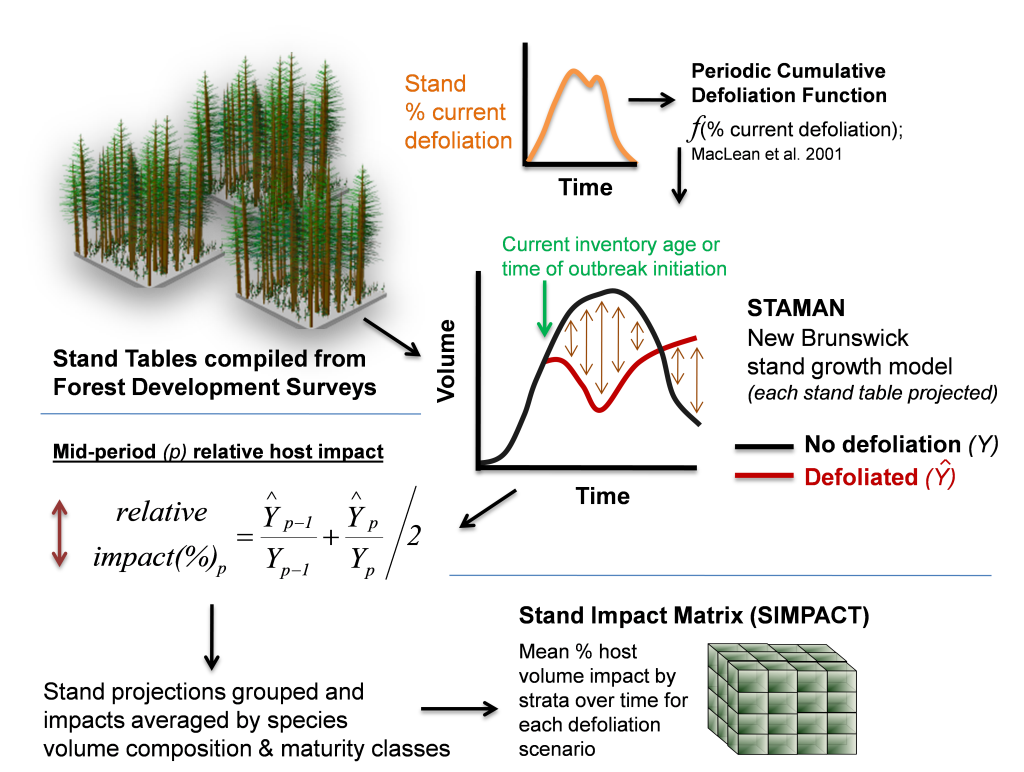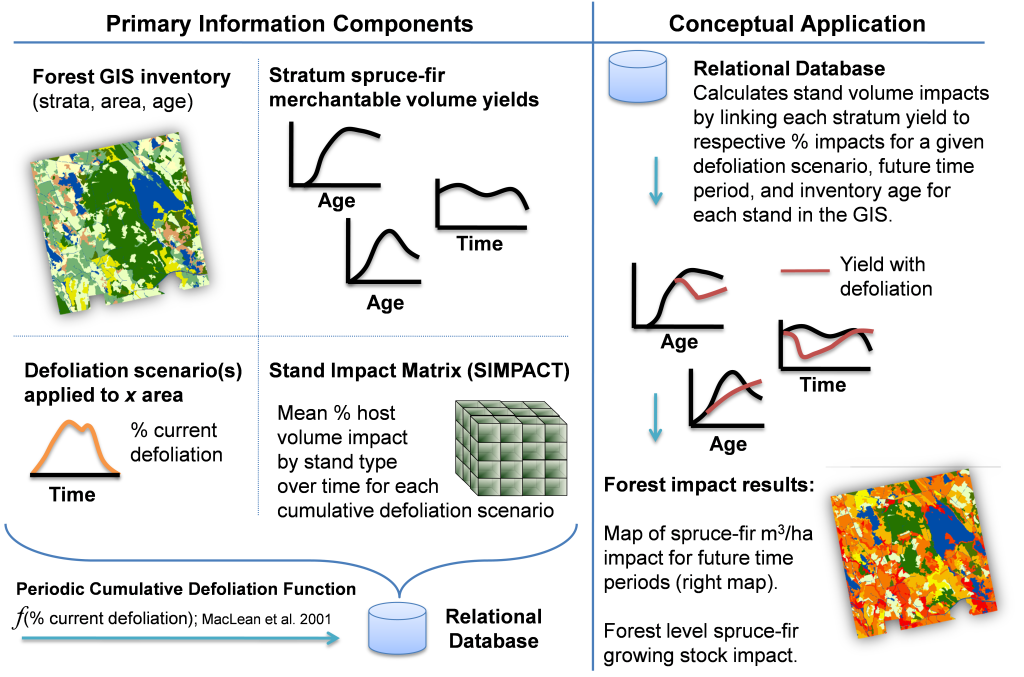Spruce Budworm Impact Calculator App
This phone or iPad app can be used to quickly understand the influence of spruce budworm and foliage protection on stand volume over time.
AndroidIn the Spruce Budworm Decision Support System (SBWDSS), these basic calculations are replicated across all stands in the forest to assist with optimization of foliage protection and salvage planning decisions: what, when, where, and how much.
Evolution of the SBWDSS & ForPRO
The SBWDSS was developed conceptually by Erdle (1989), and as a GIS software application by the Canadian Forest Service from 1992 to 1996. From 1996 to 1999, it was operationally implemented, on a cost-shared basis with industry and the provincial government, on all 6 million hectares of forest in New Brunswick, Canada (MacLean et al. 2001; 2002). Since development, it has been implemented for test areas in Saskatchewan, Alberta, Ontario, Quebec, and the state of Maine, and used operationally in SBW protection programs in Saskatchewan.
The SBWDSS calculates the marginal timber supply benefits (m3/ha) of alternative foliage protection scenarios for each stand in a forest. Core data requirements include 1) annual SBW defoliation (historical and projective) scenarios, 2) GIS of stand polygons and areas, 3) stand-type merchantable volume yields and attributes (species composition, maturity, treatment history), and 4) a look-up table of marginal (relative %) spruce-fir volume impacts by broad stand types (MacLean et al. 2001) and time since outbreak initiation for each defoliation scenario. This look-up table is more commonly known as the stand impact matrix (SIMPACT; Erdle and MacLean 1999; MacLean et al. 2001), and is derived through simulation of a range of forest inventory stand tables through a tree list model (e.g., STAMAN, Open Stand Model, Forest Vegetation Simulator), with and without defoliation, for a large number of defoliation scenarios (Fig. 1).

Figure 1. Calculation steps to construct the stand impact matrix. Percentage relative impact represents % host volume remaining for defoliated compared to undefoliated yield over time.
In the SBWDSS, relative time-dependent volume impacts from the SIMPACT are multiplied against expected undefoliated yield volumes for each stand area record within a relational database (e.g., Microsoft Access) to calculate absolute volume impact across space and time of harvest (Fig. 2). Calculation of spatiotemporal impacts allow managers to concentrate harvest and foliage protection efforts in areas with the highest potential volume loss first.

Figure 2. Information sources required and conceptual application of the SBWDSS to calculate spruce-fir stand volume impacts for alternative SBW defoliation scenarios.
More recently, Hennigar et al. (2007) developed methods to represent SBWDSS stand impacts in Woodstock (Remsoft 2015) allowing linear optimized replanning of harvest, salvage, and foliage protection treatment schedules under deterministic scenarios of outbreak. This integrated modeling approach has been developed further by FORUS Research into a software plugin for Woodstock known as Accuair ForPRO. ForPRO has been recently used to strategically evaluate potential timber supply losses and cost-benefit ratios of foliage protection programs in New Brunswick (Hennigar et al. 2013; Chang et al. 2012), Newfoundland (Iqbal et al. 2011), and Maine (Hennigar et al. 2011) for a variety of outbreak and management scenarios.
FORUS Research, with funding support from the Heathy Forest Partnership, is currently expanding ForPRO modeling components to accept budworm population forecasts as input, rather than defoliation, which will improve estimates of foliage protection efficacy and simplify modeling of host species defoliation differences. In addition, FORUS Research has developed software to auto generate foliage protection blocks and flight lines according to alternative protection program objectives (e.g., minimize populations; minimize volume losses) and constraints (e.g., program cost, spatial no fly zones), while taking into consideration plane turn time, speed, swath width, boom –on –off choices, and product deposition probability. This software has been successfully and repeatedly used in New Brunswick from 2015 to 2022 and in Newfoundland from 2021 to 2022 to spatially select, build, and trade-off block designs and program sizes for annual provincial foliage protection operations.
Contact Chris Hennigar at FORUS Research for more information about ForPRO and recent developments.
Chang, W., Lantz V., Hennigar, C., MacLean, D, 2012. Economic impacts of forest pests: a case study of spruce budworm outbreaks and control in New Brunswick, Canada. Can. J. For. Res. 42: 490-505.
Erdle, T.A. 1989. Concept and practice of integrated harvest and protection design in the management of eastern spruce fir forests. PhD Thesis. University of New Brunswick, Fredericton, NB, Canada. 161 p.
Erdle, T.A., and MacLean, D.A. 1999. Stand growth model calibration for use in forest pest impact assessment. For. Chron. 75: 141-152.
Hennigar, C.R., MacLean, D.A., Porter, K.B., and Quiring D.T. 2007. Optimized insecticide application and harvest planning to reduce volume losses to spruce budworm. Can. J. For. Res. 37: 1755-1769.
Hennigar, C.R., Wilson, J.S., MacLean, D.A., and Wagner, R.G. 2011. Applying a spruce budworm decision support system to Maine: projecting spruce-fir volume impacts under alternative management and outbreak scenarios. J. For. 109: 332-342.
Hennigar, C.R., Erdle, T.A., Gullison, J.J., MacLean, D.A. 2013. Re-examining wood supply in light of future spruce budworm outbreaks: A case study in New Brunswick. For. Chron. 89: 42-53.
Iqbal, J., Hennigar, C., MacLean, D. 2011. Modeling insecticide protection versus forest management approaches to reducing balsam fir sawfly and hemlock looper damage. For. Ecol. Manage. 265: 150–160.
MacLean, D.A., Erdle, T.A., MacKinnon, W.E., Porter, K.B., Beaton, K.P., Cormier, G., Morehouse, S., and Budd, M. 2001. The spruce budworm decision support system: forest protection planning to sustain long-term wood supply. Can. J. For. Res. 31: 1742-1757.
MacLean, D.A., Beaton, K.P., Porter, K.B., MacKinnon, W.E., and Budd, M.G. 2002. Potential wood supply losses to spruce budworm in New Brunswick estimated using the spruce budworm decision support system. For. Chron. 78: 739-750.
McLeod, I., Lucarotti, C., Hennigar, C., MacLean, D., Holloway, G., Cormier, G. and Davies, D. 2012. Advances in Aerial Application Technologies and Decision Support for Integrated Pest Management, Integrated Pest Management and Pest Control - Current and Future Tactics, Soloneski, S. (Ed.), ISBN: 978-953-51-0050-8, InTech,
Remsoft, Inc., 2008. Woodstock user guide. Remsoft Inc., Fredericton, NB, Canada. 265 p.